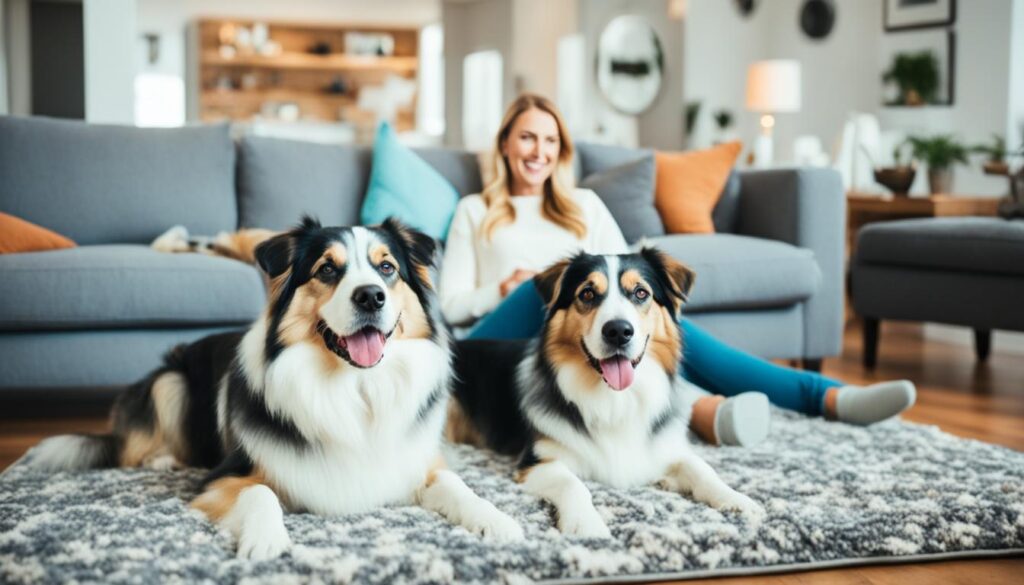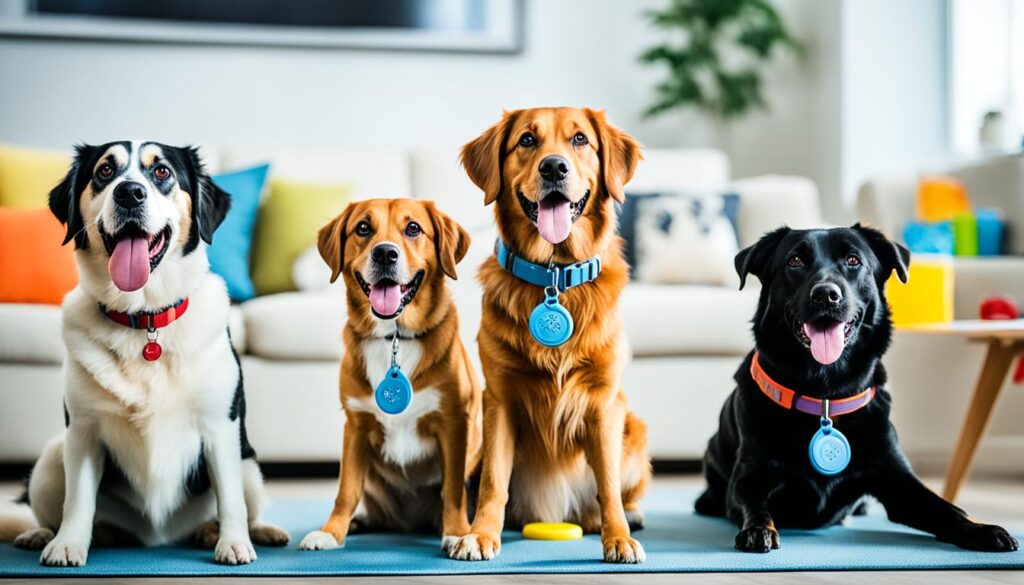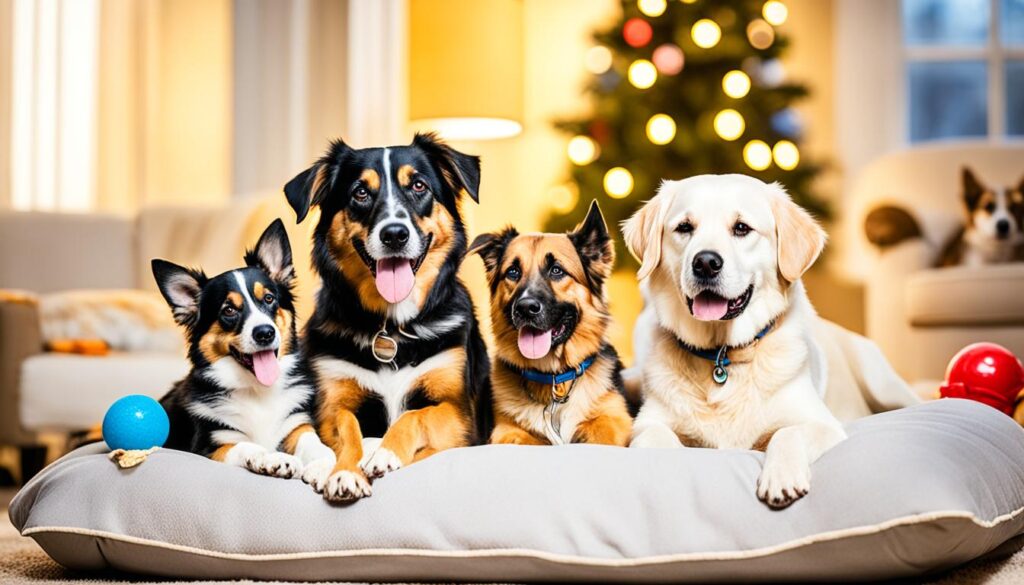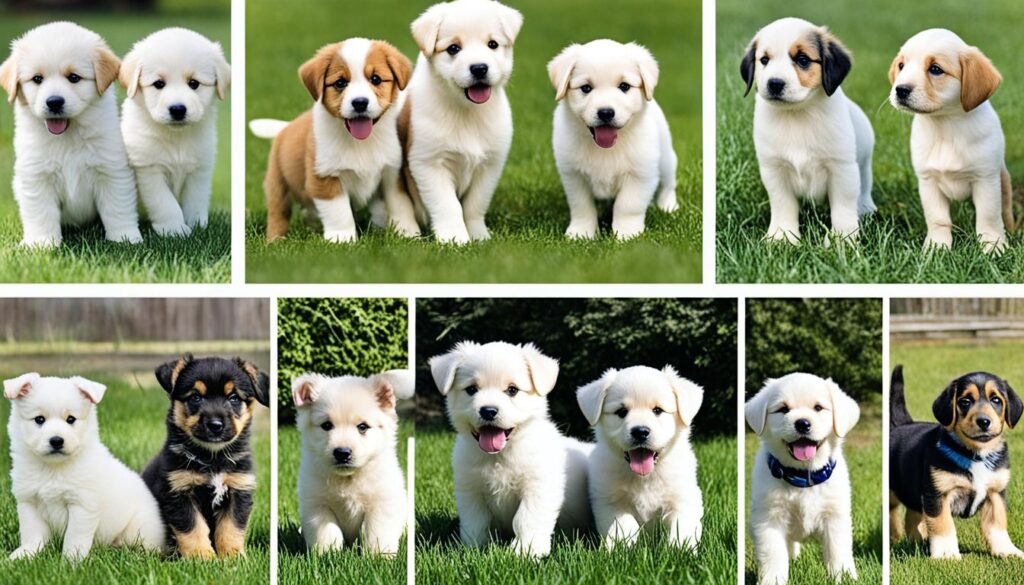Owning more than one dog brings lots of joy. But it can be challenging to keep them all happy. To make things work, you need patience and solid training skills. We’ll share expert tips to help your dogs live together peacefully.

Key Takeaways:
- Proper training and management can achieve harmony in a multi-dog household.
- Knowing the challenges and benefits of having more than one dog for practical training is essential.
- Training each dog alone and with the group, using positive rewards, and sticking to a schedule are crucial techniques.
- It helps to see if your dogs fit well together, use resources wisely, and understand dog signs to avoid fights.
- Setting up your home right, having crates and private areas, and sharing equal love and care help keep peace.
Introduction to Managing a Multi-Dog Household
Handling multiple dogs at home can be fun and fulfilling. Yet, it can be tricky too. Understanding the challenges of making your house a happy place for every dog is essential.
Understanding the challenges of a multi-dog household
In a home with many dogs, they might fight for food, toys, or your attention. This can lead to fights or one dog trying to be boss over the others. These situations can cause stress or trouble in the house.
Remember, each dog is unique. They have their likes, needs, and ways of interacting. By knowing and respecting these differences, you can better manage your pack.
Benefits of having multiple dogs
There are many pluses to having more than one dog. The top one is how they keep each other company. Dogs are inherently social and can help reduce other dogs’ feelings of being alone.
More dogs mean more playmates. They play, exercise, and explore together. This keeps them both physically fit and mentally sharp.
Finally, bringing more dogs into the family can tighten the bond with their humans. They learn from one another and build a strong sense of working together.
Setting realistic goals for harmony
Aiming for peace in a multi-dog home is realistic. Yet, total conflict avoidance may not always happen. But a peaceful, balanced space for all your pets is within reach.
Start by understanding that each dog is its being. They need time to adjust and find their place in the group. Patience is a must.
Creating a peaceful setting means thinking about every dog’s needs. It’s about giving them personal attention and playtime and setting clear rules everyone follows.
Critical Strategies for Training Multiple Dogs in a Household
Having more than one dog at home can be a great joy. But it also comes with unique challenges. Proper methods to keep the peace and encourage good behavior are essential. We’ll look at three critical strategies: individual and group training, positive reinforcement, and setting routines and rules for each furry friend.
Importance of Individual and Group Training Sessions
Training dogs one-on-one is critical to addressing their specific needs. It allows the trainer to focus on what each dog needs to learn based on their personality and how they learn best. During these sessions, the goal is to teach good habits, correct destructive behaviors, and grow the trust between the dog and its owner.
Group training is also crucial. It teaches dogs to follow commands when there are other dogs around. This reflects real-life situations, making them better at socializing, controlling their impulses, and following orders despite distractions. Dogs can also learn good habits from their peers during these group sessions.
Utilizing Positive Reinforcement with Multiple Dogs
Using rewards to encourage good behavior is a powerful tool. It’s even more critical when you have several dogs. This way, dogs learn to enjoy following the rules because they connect good things with obeying.
It’s vital to pick rewards that each dog loves. This could be treats, kind words, extra playtime, or a chance to enjoy their favorite toys. Keeping the rewards tailored to each dog helps keep them motivated. This, in turn, makes training fun for everyone involved and strengthens their bond.
Establishing Routines and Boundaries for Each Dog
Having precise schedules and rules is crucial for a happy multi-dog home. Dogs feel safe and know what’s expected when their lives are consistent. So, owners should set daily routines like when to eat, exercise, play, and sleep.
It’s also important to teach dogs where the boundaries are. They should know their limits regarding personal space, which parts of the home they can go to, and how to behave around other pets and people. Maintaining these rules and gently reminding dogs when they step out of line allows everyone to live together peacefully.

Ensuring Compatibility and Preventing Conflicts Among Dogs
Assessing compatibility before introducing a new dog
Keeping peace in a home with several dogs is about assessing if they will get along. It’s vital to look into whether their energy and temperaments match. Dogs with similar traits are likely to live together in harmony and avoid fights.
Managing resources to minimize conflict
Dogs might fight over food, toys, and even attention. To stop this, each dog must have its stuff and space. Ensuring every dog gets fair sharing helps in keeping the peace.
Reading and responding to dog body language
Learning to read dog body language is also crucial. They tell us how they feel through postures, looks, and sounds. By understanding these signs, owners can step in before a fight starts. This keeps the atmosphere calm and happy for all.
To ensure dogs live well together, owners must first match them carefully. Then, they need to manage what their dogs have and observe how they speak through actions. These steps help create a loving home for all pets.
Creating a Harmonious Environment for Multiple Dogs

Designing a living space that accommodates multiple dogs
Setting up a living space that works for many dogs is vital. They all need room to move freely and chill out, making for a peaceful home.
The role of crates and separate spaces in harmony
Using crates can help a lot. Each dog gets its cozy spot. It’s a place where they can go for quiet time, helping avoid fights and feel secure.
Having separate places for eating, resting, and fun is also good. This way, dogs have their spots for these activities. It cuts down on sharing troubles and keeps peace.
Maintaining balance and fairness in attention and care
Sharing love and care equally is essential, too. All dogs should get the same amount of attention. This prevents any one of them from feeling left out or unhappy.
Thinking about what each dog needs is critical. With crates, separate spaces, and fairness in care, you can make a joyful home for all your furry friends.
| Key Points |
| Design a living space with enough room for each dog to move and relax comfortably |
| Utilize crates and separate spaces to provide dogs with their own private areas and prevent conflicts |
| Maintain balance and fairness in attention and care to prevent jealousy and resentment among dogs |
Ongoing Maintenance and Problem-Solving in a Multi-Dog Household
Living well in a multi-dog house means you must keep the peace. It’s vital to spot any tension and deal with it quickly. This way, you can stop problems before they get big, ensuring your home is calm.
Identifying and addressing signs of tension early
Dogs might growl, snap, or show other signs of not getting along. If you see any of these behaviors, it’s crucial to act fast. By dealing with these issues early, you can help keep your dogs friendly towards each other.
How and when to seek help from a professional dog trainer
Professional dog trainers are an excellent resource for hard-to-handle situations. If you’re struggling to keep peace alone, it might be time to get help. They can offer advice and strategies to make your home a happier place for your pets.
Adjusting strategies as a dog’s age and dynamics change
Dogs’ needs and relationships change as they get older. It’s critical to adjust your approach to training to match these developments. Keeping an eye on your dogs and being ready to try new things can help maintain a peaceful home.
Conclusion
Making a multi-dog home peaceful takes time and knowing the proper training methods. You can have a happy home with your dogs by using the advice in this article.
Training many dogs might seem like a big task. Yet, it’s an excellent way for everyone, including you, to be happy. It teaches them good behavior, so they listen and love being with you.
Good training for many dogs mixes alone time and time in lessons. It’s all about being positive and setting clear rules and schedules. This makes for a calm place where dogs get along well.
Being steady and solving problems as they come keeps peace in homes with many dogs. With these tips, anyone can make their multiple dogs live together happily. It’s a journey for everyone, new or not, to build a joyful home with their furry friends.
Q: How can I introduce a new dog into my multi-dog household?
A: Introducing a new dog into an established multi-dog household requires patience and careful planning. Start by allowing the dogs to meet in a neutral space to minimize territorial behavior. Use positive training methods to encourage calm and friendly interaction, and monitor their body language closely. Gradually increase the time the dogs spend together under supervision. Reward-based training can help create harmony and maintain peace among the dogs in the household. Ensure that each dog feels secure and valued to prevent jealousy and competition.
Q: What are the critical strategies for managing a multi-dog household effectively?
A: Successful management of a multi-dog household involves establishing clear rules and boundaries to prevent chaos and ensure safety. Focus on providing individual attention and training sessions for each dog to maintain their behavioral health and reinforce your bond with them. It’s important to recognize each dog as an individual with their own needs and preferences. Employing separate feeding times and spaces can also prevent food aggression among dogs. Consistency in routine and positive reinforcement are crucial in managing a multi-dog household effectively.
Q: How can I prevent resource guarding in a multiple-dog household?
A: Preventing resource guarding in a multiple-dog household involves teaching the dogs that sharing resources can lead to positive outcomes. Train dogs separately to accept someone approaching them while they eat or play with toys, rewarding them for calm behavior. Make sure each dog has their own set of resources like food bowls, beds, and toys. Supervise closely when new resources are introduced to ensure that each dog respects the others’ space and possessions. Sometimes, feeding dogs in separate rooms can prevent competition and guarding behaviors.
Q: What are the benefits of owning multiple dogs?
A: Owning multiple dogs can benefit the dogs and their owners. Dogs in a multi-dog household can provide companionship for each other, reducing feelings of loneliness and boredom, especially when their owners are not home. This can prevent behavioral issues stemming from isolation. Additionally, dogs can stimulate each other through play and social interaction, contributing to their physical and mental well-being. Observing the dynamic and interaction between multiple dogs can be highly rewarding and entertaining for owners. However, ensuring that each dog receives individual attention is crucial to fostering a strong bond with the owner.
Q: Can dogs of different ages live harmoniously in a multi-dog household?
A: Dogs of different ages can live harmoniously in a multi-dog household with proper management and training. An older dog can often help teach a younger pup appropriate dog behavior, which can assist in the pup’s social development. However, it’s essential to consider the energy levels and health of the older dog to ensure they are calm. It is necessary to provide separate spaces where the older dogs can retreat when they need peace. Positive training techniques should encourage respectful interactions between the dogs and ensure they feel comfortable with each other.
Q: How do I ensure each dog in my multi-dog household feels loved and attended to?
A: Ensuring that each dog in a multi-dog household feels loved and attended to requires deliberate effort and planning. Allocate individual time with each dog daily for one-on-one interactions, such as walks, training, or play sessions. This helps strengthen the bond between dogs and their owners individually. Recognize and cater to each dog’s unique needs and personality traits. Celebrate each dog’s achievements and milestones to make them feel valued. Consistency in affection and rules helps maintain harmony and prevent feelings of neglect or jealousy among the dogs.
Q: What role does a dog trainer or behaviorist play in creating a prosperous multi-dog household?
A: A dog trainer or behaviorist can play a pivotal role in creating a prosperous multi-dog household. They bring professional expertise in dog behavior and training techniques, particularly in addressing aggression, resource guarding, or jealousy between dogs. A behaviorist can assess the dynamics of the dog household, identify potential issues, and recommend specific, tailored strategies to encourage positive interactions and harmony among dogs. Their guidance can be invaluable in teaching owners how to manage their dogs together and individually, ensuring a peaceful and happy home environment.

